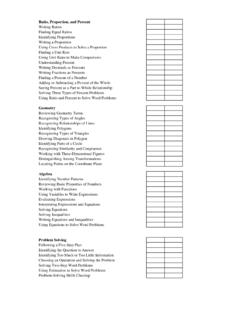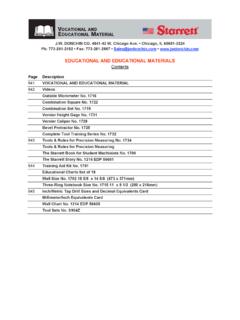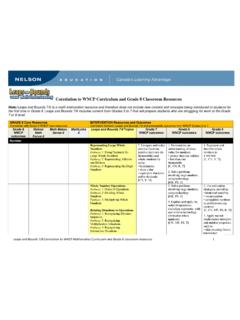Transcription of Guidelines for Technical Material
1 Guidelines for Technical Material Unified English Braille Guidelines for Technical Material This version updated October 2008 iiLast updated October 2008 iiiAbout this Document This document has been produced by the Maths Focus Group, a subgroup of the UEB rules Committee within the International Council on English Braille (ICEB). At the ICEB General Assembly in April 2008 it was agreed that the document should be released for use internationally, and that feedback should be gathered with a view to a producing a new edition prior to the 2012 General Assembly. The purpose of this document is to give transcribers enough information and examples to produce Maths, Science and Computer notation in Unified English Braille.
2 This document is available in the following file formats: pdf, doc or brf. These files can be sourced through the ICEB representatives on your local Braille Authorities. Please send feedback on this document to ICEB, again through the Braille Authority in your own country. Last updated October 2008 ivGuidelines for Technical Material 1 General Underlying rules for numbers and Print Use of Grade 1 2 Numbers and Whole Ordinal Roman Emphasis of Ancient Numeration Hexadecimal 3 Signs of operation, comparison and Algebraic Use of the braille Positive and negative Calculator Omission marks in mathematical 4 Spatial Layout and Spatial Tally 5 Grouping Devices (Brackets).
3 30 6 Simple numeric Mixed Fractions written in linear form in General fraction Extra 7 Superscripts and Definition of an Superscripts and subscripts within literary Algebraic expressions involving Multiple Last updated October 2008 Negative Examples from Simultaneous superscripts and Left-displaced superscripts or Modifiers directly above or 8 Square Roots and other Square Cube roots Square root sign on its 9 Spelling and Trigonometric Logarithmic The Limit Statistical Complex 10 Set Theory, Group Theory and 11 Miscellaneous Unusual Print Grade 1 Symbols which have more than one meaning in Embellished capital Greek 12 Bars and dots etc.
4 Over and The definition of an Two indicators applied to the same 13 Simple Arrows with unusual shafts and a standard barbed Arrows with unusual 14 Shape Symbols and Composite Use of the shape termination Transcriber defined Combined 15 Matrices and Enlarged grouping Omission Dealing with wide Grouping of Last updated October 2008 Last updated October 2008 vi16 Chemical Chemical Atomic mass Electronic Chemical Structural 17 Computer Definition of computer Line arrangement and spacing within computer Grade of braille in computer Guidelines for Technical Material 1 Guidelines for Technical Material 1 General Principles Spacing The layout of the print should be preserved as nearly as possible.
5 However care should be taken in copying print spacing along a line as this is often simply a matter of printing style. Spacing should be used to reflect the structure of the mathematics. Spacing in print throughout a work is often inconsistent and it is not desirable in the braille transcription that this inconsistency should be preserved. For each work, a decision must be made on the spacing of operation signs (such as plus and minus) and comparison signs (such as equals and less than). When presenting braille mathematics to younger children, include spaces before and after operation signs and before and after comparison signs.
6 For older students who are tackling longer algebraic expressions there needs to be a balance between clarity and compactness. A good approach is to have the operation signs unspaced on both sides but still include a space before and after comparison signs. This is the approach used in most of the examples in this document. There are also situations where it is preferable to unspace a comparison sign. One is when unspacing the sign would avoid dividing a complex expression between lines in a complicated mathematical argument. Another is when the comparison sign is not on the base line (for example sigma notation where i equals 1 is in a small font directly below).
7 When isolated calculations appear in a literary text, the print spacing can be followed. Last updated October 2008 Guidelines for Technical Material Underlying rules for numbers and letters Listed below is a summary of the rules for Grade 1 mode and Numeric mode as they apply to the brailling of numbers and letters in mathematics. Refer to the complete versions of these rules for more detail. Grade 1 mode A braille symbol may have both a grade 1 meaning and a contraction ( grade 2) meaning. Some symbols may also have a numeric meaning. A grade 1 indicator is used to set grade 1 mode when the grade 1 meaning of a symbol could be misread as a contraction meaning or a numeric meaning.
8 Note that if a single letter (excluding a, i and o) occurs in an algebraic expression, it can be misread as a contraction if it is "standing alone" so may need a grade 1 indicator. The same is true of a sequence of letters in braille that could represent a shortform, such as ab or ac, if it is "standing alone". A letter, or unbroken sequence of letters is "standing alone" if the symbols before and after the letter or sequence are spaces, hyphens, dashes, or any combination, or if on both sides the only intervening symbols between the letter or sequence and the space, hyphen or dash are common literary punctuation or indicator symbols.
9 See the General Rule for a full definition of "standing alone". Numeric mode Numeric mode is initiated by the "number sign" (dots 3456) followed by one of the ten digits, the comma or the decimal point. The following symbols may occur in numeric mode: the ten digits; full stop; comma; the numeric space (dot 5 when immediately followed by a digit); simple numeric fraction line; and the line continuation indicator. A space or any symbol not listed here terminates numeric mode, for example the hyphen or the dash. A numeric mode indicator also sets grade 1 mode. Grade 1 mode, when initiated by numeric mode, is terminated by a space, hyphen or dash.
10 Therefore while grade 1 mode is in effect, a grade 1 indicator is not required except for any one of the lowercase letters a-j immediately following a digit, a full stop or a comma. (Note that Grade 1 mode, when initiated by numeric mode, is not terminated by the minus sign, .) Last updated October 2008 Guidelines for Technical Material Print Symbols One of the underlying design features of UEB is that each print symbol should have one and only one braille equivalent. For example the vertical bar is used in print to represent absolute value, conditional probability and the words "such that", to give just three examples.






